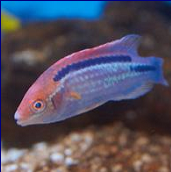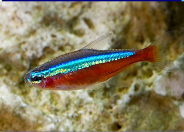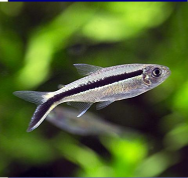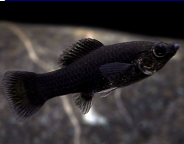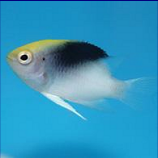



Pregnant female guppies have enlarged and darkened gravid spots near their anal vents. Just before birth, the eyes of fry may be seen through the translucent skin in this area of the female's body. When birth occurs, individual offspring are dropped in sequence, typically over a period of one to six hours. The female guppy has drops of two to 200 fry at a time, typically ranging between 30 and 60.
Well-fed adults do not often eat their own young, although sometimes safe zones are required for the fry. These also serve to shield the pregnant female from further attention from the males, which is important because the males sometimes attack the females while they are giving birth. Well-planted tanks that offer barriers to adult guppies shelter the young quite well. Guppy grass, water sprite, water wisteria, duckweed, and java moss are all good choices. Young fry take roughly three or four months to reach maturity. Feeding fry live foods, such as baby brine shrimp, microworms, infusoria and vinegar eels, is recommended.

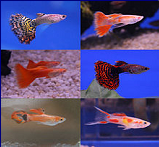
The guppy also known as millionfish and rainbow fish, is one of the world's most popular freshwater aquarium fish species. It is a member of the family Poeciliidae and, like almost all American members of the family, is live-bearing. They are highly adaptable and thrive in many different environmental and ecological conditions. Male guppies, which are smaller than females, have ornamental caudal and dorsal fins, while females are duller in color.
Guppies prefer a hard-water aquarium with a temperature between 78 and 82 °F. Guppies are generally peaceful, though nipping behavior is sometimes exhibited between male guppies or towards other top swimmers like platies and swordtails, and occasionally other fish with prominent fins, such as angelfish. Guppies should not be kept as a single fish in an aquarium because both males and females show signs of shoaling, and are usually found in large groups in the wild. Its most famous characteristic is its propensity for breeding.










The black skirt tetra, petticoat tetra, high-fin black skirt tetra, black widow tetra and blackamoor, is a freshwater fish of the characin family (Characidae).
The black skirt tetra is often kept in aquariums. Growing up to 3.0 inches in length, the black tetra has a roughly tetragonal body shape and is greyish in color, fading from near black at the tail to light at the nose. Two prominent, black, vertical bars appear just posterior to the gills. It is easily distinguished from all of its congeners by the presence of a dense field of dark chromatophores spread homogeneously over the posterior one half of the body unlike the lack of such pigmentation in all congeners.
The black skirt tetra is a schooling fish that feeds on small crustaceans, insects, and worms. The black skirt tetra is a common fish that is widely available for purchase.
The species reaches sexual maturity at about two years of age. Like most characins, this species spawns by intermittently releasing and fertilizing eggs among plants. It frequently eats its own eggs, so keepers remove the fish after spawning.
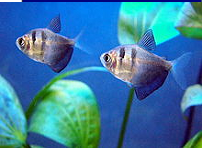
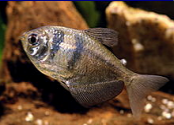
Mollies rank as one of the most popular feeder fish due to high growth rate, birth size, reproduction, and brood number. Contrary to popular belief, this species of fish is actually a freshwater species, spending little time in brackish water before swimming back to their freshwater biotope. Mollies appear to be a hardy and highly adaptable species (this has been diluted over years of interbreeding in tank-bred specimens).
Mollies are similar in appearance to their livebearer cousins, the platy, swordtail and guppies; the molly tends to be slightly larger and more energetic. Many aquarists note the stronger individuality and aggression in keeping mollies versus platies, who appear much more docile.
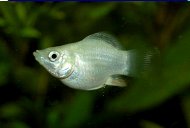

The dwarf spotted danio is a hearty little fish from Myanmar that has had a long history in the aquarium industry. The earliest written descriptions of the spotted danio are from 100 years ago. Since the 1960s, the export of this fish was affected dramatically by the political instability in what was then called Burma. In recent years, the country has stabilized and this beautiful fish has started to make a comeback in the aquarium trade.
Pearl Danios have been a popular staple in the aquarium industry for over 100 years. Pearls can be added to almost any community aquarium and they are tolerant of a wide range of water conditions and live agreeably with most species of fish. Like other danio species, keep them in schools of at least four or more.
Zebra danios are a favorite of freshwater fish hobbyists because of their ease of care, and they are prolific breeders and the easiest type of egglayers to breed. These fish are attractively striped, black and white zebra-patterned body. They are active swimmers. Zebrafish are very durable and can withstand an impressive range of water temperature and conditions. They will generally do just fine without a water heater as they are comfortable at temperatures down to the low 60s F.

The Bird Wrasse, come from the Indo-Pacific region. Females are a brown to black color with a lighter colored face. Males have a blueish-green body with a lime green patch near the pectoral fins. These wrasses have a unique long beak-like mouth that allows them to reach prey in crevices.
These wrasses are carnivores and require a diet rich in meaty foods, such as brine and mysis shrimp, high-quality frozen foods, pieces of fresh seafood, and flake and pellet foods.
Bird Wrasses can reach up to 11 in. and require an aquarium of at least 125 gallons with plenty of live rock and a fine sand bed. They are semi-aggressive and will eat or attack fish smaller than themselves. They are also jumpers and need to be kept in an aquarium with a lid.
They are not considered reef safe.
NOTE: If you want to keep a pair, the female must be introduced to the tank before adding a male. If a female is introduced and maintained without a male, it will turn into a male.
Wrasses for the aquarium can be divided into two large groups: those that burrow and those that do not. They include some of the most difficult and easiest fishes to keep. They also have a wide variety of temperaments.
Wrasses are mostly long, cigar-shaped or flattened cigar-shaped fish. They swim basically using their side pectoral fins, and when a burst of speed is required, they use their caudal fin. Even though they do not have a large mouth, they do have strong lips with large, pointed teeth. So much the better to crush their favorite foodstuffs.
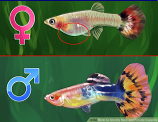
Lubbock's Fairy Wrasse (Cirrhilabrus lubbocki) is a small brightly colored fairy wrasse with highly variable color. Males have 2 dark burgundy horizontal marks on their orange/pink flanks or may have blue sides, an orange head and yellow dorsal. Females are pink with some yellow coloration.
Fairy Wrasses have a generally placid temperament and tolerate most tankmates, provided that they have plenty of places to escape to and hide to feel secure. Males are usually brighter in color than juveniles and females, and males will show their colors and behavior to the best advantage in the presence of a female.
They can usually be found around rubble piles and rockwork and should have plenty in the tank to retreat to. These wrasses are perfect for reef aquariums. Most will not harm corals, polyps or most invertebrates but should not be kept with very small crustaceans like Sexy Shrimp. These fish are known jumpers, so the tank should be covered at all times.
These wrasses will usually accept most types of small foods once acclimated. They can be fed a varied diet of flakes, frozen and fresh foods like copepods, Cyclops, brine shrimp, mysis shrimp and similar items.
The Red Fin Fairy Wrasse originates from the Philippines and enjoys the rubble areas of the outer reefs . This peaceful wrasse is a great addition to any Reef Aquarium adding stunning coloration. Like other wrasses, the males during courtship will display increased color intensity. Colors may vary depending on the fish's mood.
The Fine Spotted Fairy Wrasse is mostly green in color with a white underside. Their body is adorned with many small white spots that do intensify depending on the mood of the fish. The male and female of this species are very similarly colored, but when courting, the male changes to various colors.
Scientific Name: Cirrhilabrus punctatus - Minimum Tank Size: 90 gallons
Care Level: Easy - Temperament: Peaceful
Water Conditions: 72-78° F, dKH 8-12, pH 8.1-8.4, sg 1.020-1.025
Max. Size: 5" - Color Form: Blue, Green, Red, White, Yellow

They are a hardy species perfect for beginning aquarists, and don't require a large tank to thrive. Driftwood and rocks are both ideal decor items, and they will appreciate live plants to hide amongst. They are peaceful and will do well with a wide variety of tankmates.
Their scientific name is hemigrammus caudovittatus from the Characidae Family. Their origin is china.
Care Level: Easy - Temperament: Peaceful Lifespan: 3-5 years
Water Conditions: 72-77° F, KH 4-8, pH 6.0-6.5 - Maximum Size: 2.5"
Diet: Omnivore - Minimum Tank Size: 10 gallons
Fine Spotted Fairy Wrasse
Cardinal Tetras are a very popular freshwater fish due to their ease of care for beginners and stunning coloration. They have vibrant, iridescent blue bodies and bright red stripe that runs down its entire body, compared to the Neon Tetra which only has the red stripe on half.
They will appreciate a planted tank with plenty of hiding places and dim lighting. A schooling fish, they feel the most secure in groups of at least 6 but even larger is preferable and many of them will create a beautiful display of color in a peaceful community aquarium. Since these fish can be sensitive to nitrate levels, it is ideal to stay on top of water changes and make sure your water is always at optimal quality. This is especially important if they are being kept in a small tank that will require more maintenance. They should not be added to a tank that hasn't been properly cycled.
The Sergeant Major Damsel is a very deep bodied fish. The tail fin is deeply forked, allowing for serious swimming speed when they need it. This species is one of the larger damselfish, though not the largest. It commonly grows to 5.9 inches in length, though some specimens have been reported reaching up to 8 2/3 inches in the wild. Similar to other damselfish, their life span in the wild is likely 2 to 6 years and they probably live the typical 15 years in captivity.
Minimum Tank Size: 55 gallons - Care Level: Moderate
Temperament: Semi-aggressive - Origin: Eastern Asia
They are a hardy species and perfect for beginning aquarists, and don't require a large tank to thrive. Driftwood and rocks are both ideal decor items, and they will appreciate live plants to hide amongst. They are peaceful and will do well with a wide variety of tankmates.
They should be given a varied diet that includes both meaty preparations and vegetable matter in the form of live, frozen, pelleted and high quality flake foods.
Black molly: It is a melanistic breed which are black all over. It is one of the most well-known aquarium fishes and nearly as easy to keep and prolific as guppies.
Danios are a hardy, lively family of fish that do well in cooler water, making them suitable for unheated tanks. Here are some of the popular Danio species, so you can consider which one would be a good fit for you.
Balloon molly: This fish has a deformed spine due to a genetic defect that gives it it's appearance. Through selective breeding it is now widely available. Balloon mollies can still reproduce and live a normal life comparable to that of other mollies, but it has garnered controversy due to the belief that its defect gives it a shortened lifespan and a susceptibility to health problems.
Rolland's Damselfish is also known as the Black Cap Damselfish, and these fishes originate from the Melanesia. They are a beautiful fish colored in yellow, black and white, and are relatively mild mannered for a Damselfish. These fishes will add color and activity to any saltwater community or reef aquarium.
QUICK FACTS
Scientific Name: Chrysiptera rollandi
Minimum Tank Size: 30 gallons
Care Level: Easy
Temperament: Semi-aggressive
Max. Size: 4"
Color Form: Black, White, Yellow
Diet: Omnivore
Family: Pomacentridae
The Blue Velvet Damsel Neoglyphidodon oxyodonis is one of the most attractive damselfish as a juvenile. Strikingly colored when young, it has flashy neon electric-blue horizontal stripes dashed across its face and upper body which contrast dramatically with its dark body. It also has a vertical white or yellow bar dividing the body just in front of the dorsal fin. As they grow older however, the stripes fade and the fish become a grayish blue or brown color overall.
QUICK FACTS
Minimum Tank Size: 30 gallons
Care Level: Easy
Temperament: Aggressive
Max. Size: 6"
Color Form: Black, Blue, White
Diet: Omnivore
Origin: Eastern Asia
Family: Pomacentridae
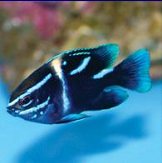

Cremesicle Mollies have extrudable wide mouths that can suck in big flakes compared with many other fish like Platys. Cremecicle Lyretail Mollies are bred for their unusual coloration and finnage. They have white and pale orange bodies with varying patches and patterns. The fins are longer than normal mollies and most have a forked lyretail.
As with all livebearers, they are prolific breeders and are best kept in a "harem" ratio of one male to two or three females. This allows the females to have some relief from the males' constant pestering. Males have a modified pointed anal fin known as a "gonopodium" while this fin is held fanned out in females.
Creamsicle lyretail Molly
The Electric Blue Hap is a brilliant species of cichlid fish native to Lake Malawi in Africa. It prefers to live in caves and the crevices in rocky substrates with crushed coral, if possible. Electric Blue Haps can reach a length of 7.9 in. long. The Electric Blue Hap is a very popular aquarium fish because of its coloration. Stocking large numbers of these fish together will prevent a single fish from being the target of aggression. The females are more of a drab grey in comparison and slightly smaller. Electric Blue Haps prefer rocky decorations with coral sand bottom.
















